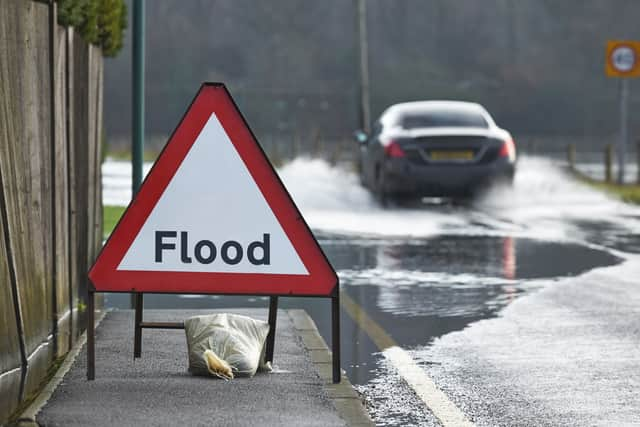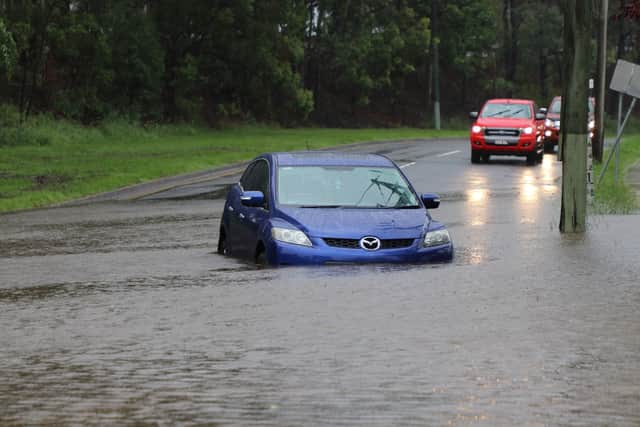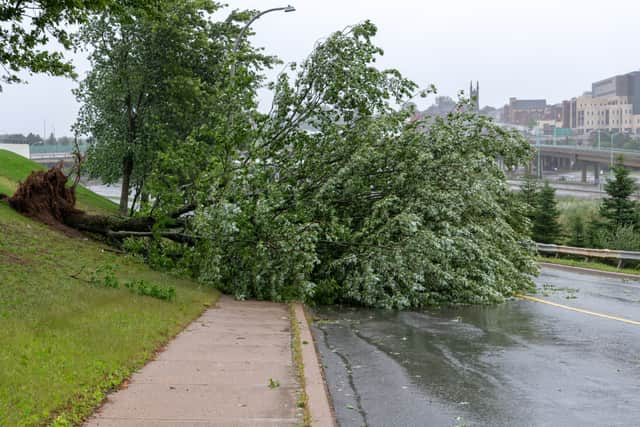Driving during flood warnings: how to safely tackle heavy rain, flooding and storms under Met Office warnings
and live on Freeview channel 276
Flood and rain warnings are in place across the UK as heavy rain has hit much of midlands and south.
Environmental bodies in England, Scotland and Wales are warning of flooding as the Met Office announced yellow rain warnings for parts of south-west England and Wales.
Advertisement
Hide AdAdvertisement
Hide AdTwo days of persistent heavy rain have caused problems in the regions, on top of other parts of the country already dealing with the effects of heavy downpours.
The RAC urges drivers to “be on their guard” when heading out in heavy rain, with the motoring group’s breakdown spokesman Rod Dennis commenting: “The dangers of driving in freezing conditions are well known, but it’s easy to underestimate the risk that rain, especially heavy downpours, presents.”
While it’s advisable to avoid travelling in stormy weather if you can, many people still need to get around, so here are our tips on staying safe on the roads during storms and flooding.
How to drive through flood water
Storms inevitably bring flooding and large patches of standing water which can catch out careless drivers.
Advertisement
Hide AdAdvertisement
Hide AdBe wary of puddles and standing water. What might look like a minor puddle at the side of the road could be hiding a deep pothole or dislodged drain cover that could cause serious damage to your car. Driving through even fairly shallow puddles could also cause aquaplaning.


If you come across a seriously flooded road the best advice is to try to find an alternative route. A detour is better than risking your safety or damaging your car.
If you have to drive through a flood, first check how deep the water is. Get out and check, preferably using a stick to gauge the depth. Remember as little as six inches of flowing water could knock you off your feet, so take care. According to the AA, just a foot of moving water will float a car and two feet of standing water is enough to do the same. It recommends that you shouldn’t try driving through anything more than four inches deep.
If you’ve determined it’s safe to proceed, take it slowly and stick to the centre of the road. The crown, as it’s known, is the highest point so should be the shallowest section of the flood.
Advertisement
Hide AdAdvertisement
Hide AdDon’t stop. Maintain a steady slow speed (3-4mph) and don’t change gear. If you need to, slip the clutch to keep revs up and speed down. In an automatic try braking gently while maintaining pressure on the accelerator. Moving slowly will help create a small bow wave which will stop the engine bay flooding. Stopping could flood the engine bay or could allow water to flow into the exhaust pipe - both of which are bad news.


Be aware of other vehicles and pedestrians. You don’t want to soak pedestrians or potentially flood or damage anyone else’s car.
If you do get stuck, it’s usually safest to remain in the car and call for help. Obviously, you need to use your common sense as to whether this is the best option depending on your circumstances.
Once you’re clear of the flood, dry your brakes. Apply them gently while driving slowly to remove the water from them.
Advertisement
Hide AdAdvertisement
Hide AdRemember, modern cars are full of complex electrical systems which are vulnerable to water damage. Rushing through a puddle that forces water into the engine bay or wading into a deep flood could quickly cause expensive damage. Every year the AA rescues almost 9,000 vehicles that have driven through or become stuck in flood water, with an estimated insurance bill of more than £34 million.
How to drive in strong wind
If your journey is necessary, take some time before setting off to check local road reports for any closures or disruption caused by the storm. Five minutes research before you set off or taking a slightly different route could save you from a long wait or diversion along your way. Try to stick to major routes.
Keep a firm grip of the steering wheel. It sounds simple but many drivers have a habit of holding the wheel lightly or with only one hand. A strong gust of wind is enough to knock your car off course and if you don’t have a proper grip of the steering wheel you could lose control completely.
Slow down and leave space. Strong winds lead to lots of debris on the road, so reducing your speed gives you more time to see and react to obstructions such as fallen branches. Some vehicles, including motorbikes and high-sided trucks are also more vulnerable to the effects of the wind, so allow extra space when passing them.


Advertisement
Hide AdAdvertisement
Hide AdWhen you reach your destination, park away from trees, bins and anything else that could be knocked over or blown into your car by heavy wind.
How to drive in a thunderstorm
If you’re in the middle of a full-blown storm the simplest piece of advice is to avoid travelling if you can. Of course, that’s not always possible so if you must travel during a storm give yourself more time to complete your journey and be prepared to pull over and stop if things get particularly bad.
If you can, choose more sheltered roads and try to avoid routes you know are vulnerable to flooding.
Go slowly, put on your lights and increase your distance to other vehicles. Heavy rain or hail will affect your view of the road ahead so you’ll need more time to react. Wet roads also increase cars’ braking distance significantly and puddles create the risk of aquaplaning - when all four wheels lose contact with the road surface and leave you with no control of the vehicle. Reducing your speed can help cut the chance of this happening.
Advertisement
Hide AdAdvertisement
Hide AdHigh winds can also make keeping control difficult, battering the car’s sides and even getting underneath and affecting handling and braking. Keep a firm grip on the wheel with both hands and be prepared for sudden gusts affecting the car.
Give vulnerable road users such as cyclists, motorcyclists and pedestrians more space - they’re more likely to be knocked about by high winds or affected by puddles.
Am I safe from lightning in my car?


In most cases, your car will protect you from lightning.
The Met Office advises that you close all the windows and stay inside your car. If lightning does hit your car the metal bodywork should act as a Faraday carriage, directing the current around the outside of the vehicle and into the ground rather than allowing it to reach passengers inside.
However, the Met Office also warns that convertibles with fabric roofs could be at risk of catching fire if struck directly, and that a lightning strike can still send a current through internal electronics and internal metal components such as metal door handles or pedals.
Comment Guidelines
National World encourages reader discussion on our stories. User feedback, insights and back-and-forth exchanges add a rich layer of context to reporting. Please review our Community Guidelines before commenting.